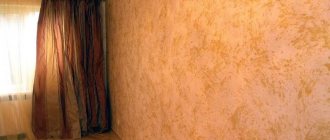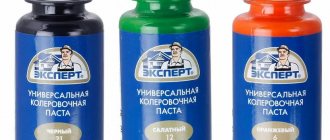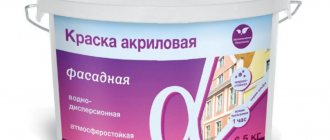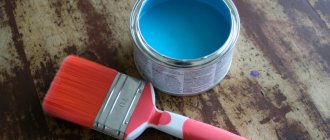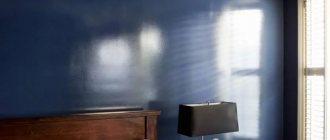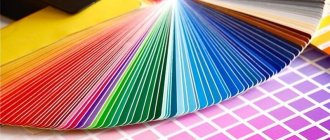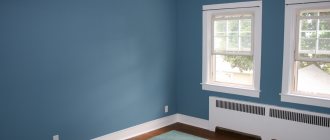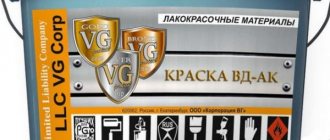Review of produced brands
“Harmony” creates a completely matte surface and is suitable for covering walls in a children’s room, living room or bedroom.
The paint applies smoothly to concrete, putty and plastered surfaces. The matte shade can hide the imperfections of the wall. Its composition belongs to the safe type M1, so you don’t have to worry about the health of your loved ones. Paint consumption on a weakly absorbent surface is 1 liter per 12 sq.m., on a highly absorbent surface—1 liter per 7 sq.m.
Joker paint is a popular model in the Tikkurill paint line. This is an interior coating with a smooth, silky effect. Suitable for application to the walls of the living room, kitchen, children's rooms and corridors.
The paint is a hypoallergenic coating, which is confirmed by the “eco-label” that marks the brand.
This type of paint has more than 20 thousand different shades
When choosing a color, you need to pay attention to the marking “A” for the surface of light colors and “C” for darker shades. Paint consumption for a highly absorbent surface is 1 liter per 7-9 sq.m.
For a “non-absorbent” surface - 1 liter per 10-12 sq.m.
Paint consumption for a highly absorbent surface is 1 liter per 7-9 sq.m. For a “non-absorbent” surface - 1 liter per 10-12 sq.m.
In order to create the beauty of walls and floors, you need to choose Euro12 paint. It is semi-matte and suitable for frequent washing. This is convenient in high-use areas (schools or hospitals).
In houses it is suitable for plastered, concrete and brick surfaces. You can cover your heating radiator with it, choosing from a variety of colors and shades. Paint consumption: for 10-11 sq. m will take 1 liter of product. With an uneven surface - 1 liter per 5-7 sq.m.
"Euro 2" is the best option for covering the ceiling space. The deep-matte interior paint adheres perfectly and, if necessary, is resistant to cleaning with wet cleaning agents.
There is practically no smell from the coated surface. Consumption for low absorption - 1 liter per 10 square meters. m. For strong absorption - 1 liter per 3 sq.m. But, unfortunately, Euro 2 is currently out of production.
For surfaces with high humidity, use Euro 20 paint. It is not subject to wear and tear in bathrooms.
This paint prevents mold. The coating is semi-matte, with particular resistance to water vapor emissions.
It is also used in dry rooms where daily cleaning is required. The paint dries in 4 hours and can be applied even to old paintwork. Consumption on a weakly absorbent surface is 1 liter per 12 sq.m., and for highly absorbent surfaces - 1 liter per 7 sq.m.
Tikkuril paint "Euro 3" is semi-matte, to create rich color in the interior. It is used in rooms with moderate load. Withstands daily washing. Dries quickly and has no odor.
With its help you can create a magnificent interior using any of 20 thousand shades. This coating is consumed with low absorption: 1 liter per 12 sq. m, and with strong absorption - 1 liter per 7 sq.m.
Euro 7 paint is widely used for painting walls and ceilings. It is latex with a matte effect. Lays flat on concrete, brick and fiberboard surfaces. Used to create a unique indoor interior.
With weak absorption, the consumption of such a coating will be 1 liter per 12 sq.m., with abundant absorption - 1 liter per 7 sq.m.
Matte interior enamel “Pesto 10” is used to cover wooden, iron and fiberboard surfaces. Resistant to frequent washing of wall and ceiling surfaces. It has no pungent odor and is absolutely safe in composition.
This is especially important if there are small children in the family. The consumption of such a coating with low absorption is 1 liter per 12 sq.
m, with plenty - 1 liter per 10 sq.m.
Euro Sealing paint is highly opaque and is suitable for creating a matte color in white tones. This paint is suitable for rooms with low traffic and mainly for the ceiling.
Suitable for concrete, brick and fiberboard surfaces. If there are defects on the surface, Euro Sealing will easily hide them. Paint consumption for weak absorption: 1 liter per 10 sq.m., and for strong absorption - 1 liter per 3 sq.m.
Painting with Luya from Tikkuril will not only create a matte surface effect, but will also protect against mold and fungi. Consumption for weak absorption: 1 liter per 8 sq.m., for heavy absorption - 1 liter per 5 sq.m. m.
Remontti-Yassya paint is acrylic, for a designer approach to the ceiling and walls. Suitable for frequent wet cleaning. Environmentally safe for humans. Painting consumption with weak absorption: 1 liter per 12 sq.m., with strong absorption - 1 liter per 7 sq.m.
Consumption of water-based paint per 1m2
The quality of the prepared surface - insufficient application of putty and primer makes it necessary to use a larger volume of paint to compensate for possible missing binding elements. The use of a standard construction roller in painting can cause some deviation from the consumption rates per 1 m2 declared by the paint manufacturer. In terms of speed of application and convenience, a roller is the most suitable tool, however, it is not the most economical in terms of material consumption. The problem is that today only the “lazy” do not produce water-based emulsion.
The modern market for such products is overcrowded and it would be useful to pay increased attention to the inscriptions on the labels, the contents of which sometimes contain some inconsistencies
- acrylic - the most economical;
- silicone - occupies the second position in terms of consumption;
- silicate – third place in the economy ranking;
- polyvinyl acetate – in fourth place;
- latex is at the bottom of the list.
- promise of consumption of one kilogram of composition per 15 m2;
- while most manufacturers voice an average consumption rate of 1 kg per 10 m2.
After the acrylic water-based material dries, a reliable and durable protective layer is obtained, which is not afraid of mechanical stress and high humidity. In most cases, acrylic paints are environmentally friendly and safe for human health
They are suitable for treating walls both indoors and for façade and street work. First of all, it is important to decide what type of paint and varnish material will be used to paint the ceiling or walls. The characteristics of water-based paints and their consumption are determined by the composition of the material
Here is a list of the main types of water-based dyes and their consumption for single-layer and double-layer application: These water-based mixtures are based on silicone, to which other substances are added, so that after painting the surface remains vapor-permeable. Silicone paints can be used not only for walls and ceilings, they can even be applied to the floor, where they will prevent the appearance of mold and mildew. In stores today you can buy polyvinyl acetate water-based paint mixture that contains PVA glue. Polyvinyl acetate dyes have minimal resistance to moisture.
The consumption of this paint is the same as that of mineral dyes. They include any natural minerals, such as cement, slaked lime and others. These coloring mixtures are used only for internal finishing and are used for application to brick and concrete bases.
Typically, the consumption of water-based paint per 1 m2 is approximately 550 grams, and 350 grams for the second application.
Properties of the surface to be painted
Porous and textured walls consume more volume, untreated wooden surfaces are also “gluttonous,” while prepared walls or ceilings coated with a layer of putty and primed will require less volume.
It will not be possible to save money by painting plasterboard floors or wallpaper for painting, since these materials absorb moisture in large quantities, but metal, on the contrary, will “take” a minimum of paint.
Concrete is considered to be an ideal base, and consumption rates for water-based paint are usually calculated relative to the properties of the concrete surface.
A smooth wall will take less coloring liquid than a textured one
Comparison of materials from Dulux, Tikkuril and other popular manufacturers
We paint the walls
Each manufacturer improves the technical characteristics of the material with its specific additives. As a result, the hiding power of similar compositions varies from company to company. The table shows white matte paint for the ceiling.
| Firm | The basis | Coverage rates 1 liter, per m2 |
| Dulux | latex | 9 — 13 |
| Dulux | water-soluble | 7 |
| Marshal VD | water-dispersed | 7 — 9 |
| Tikkurila Fincolor | water-dispersed | 7 — 9 |
| Tex | water-soluble | 4 — 6 |
| Tex | based on latex and acrylic | 9 — 12 |
| Beckers | latex | 8 — 12 |
| Beckers | water-based | 7 — 10 |
When buying paint, add to the estimated quantity the cost of losses of 5 - 7%, depending on experience and the location of the surface. The smallest for the floor, since there is nowhere for liquid to drip and drain. For walls, consider the tool:
- spray gun – 3%;
- roller with medium pile 4 - 5%;
- brush up to 7%.
The largest amount of the composition is absorbed when applying the first layer. High-quality soil and materials from one manufacturer save their costs and drying time.
Features of use
Surface absorption has a great influence on the mixture consumption. This is the porosity, roughness and humidity of a certain material, as well as the ambient temperature. Thus, a metal surface will absorb less composition than plastered walls. And for wood you will need more of it than for plastered walls.
If the composition is too viscous, it is difficult to distribute over the surface, drying will be long, and the strength of the coating will be low. To reduce the consumption of the mixture, the surface is pre-prepared. A high-quality putty, sanded and primed wall will reduce the consumption of water-based emulsion.
Application of PF 115
The main advantage of PF 115 enamel is its versatility. Experts classify this substance as a paint and varnish material for use on all surfaces. That is why it has earned particular popularity in the building materials market.
It is possible to combine enamel with other coating agents, such as primer. After application, the coating is not subject to spreading or smearing.
It forms a dense film with a smooth coating.
The name of the enamel begins with the abbreviation PF, which stands for pentaphthal or alkyd-based resin.
This type of paint is used for work:
- external type with finishing;
- for covering various types of surfaces: metal, wood or plastic;
- for carrying out work in the interior of the room.
This type of enamel can withstand high atmospheric loads, such as snow, rain and low and high temperatures. That is why it is widely used both in home painting and in external work.
The application of enamel to the surface to be coated can be done using an ordinary brush, dipping or pouring. Spraying is also allowed if a special apparatus is available.
The substance contains the following components:
- Pentaphthals, which experts classify as polymer substances.
- Resins produced by various, including modified, methods. They allow you to speed up the drying process of the surface.
- Semi-dried oils and resins with special composite mixtures in small quantities.
You may be interested in an article about Tikkuril paint consumption per 1 square meter.
Main characteristics of the water-based composition
Essentially it is an emulsion. It consists of two immiscible liquids - continuous and dispersed form. The smallest polymer particles are suspended. In this case, water does not dissolve, but only dilutes the components. It also contains pigment, thickener and latex, an antiseptic.
The main indicator of the coloring mass is viscosity. It is measured with a viscometer and should be 40–45 s for working with a brush and 20–25 for a spray gun. Specific gravity – 1.35 kg per liter.
Water-dispersion moisture-resistant paintSource stroy-podskazka.ru
After the composition is applied to the surface, the water evaporates and the polymer film hardens, and is subsequently not afraid of the action of liquid. Drying time depends on humidity and air temperature. So at 20°C, humidity 65%, the drying period can vary from 2 to 24 hours. The paint can be stored for up to 2 years if kept in a cool place. The emulsion should not be subject to freezing.
Manufacturers
Below is a list of the best manufacturers of paint and varnish products:
Dufa Superweiss – durable and pure color
Paint is used in small rooms and allows you to visually increase the volume of space.
Caparol CapaSilan - the manufacturer focuses on silicone coating for ceilings. The paint has the ability to cover small cracks up to 2 mm.
Dulux is the best option when painting ceilings
Country of origin: Great Britain.
"Oreol Discount" is a ceiling paint that dries 1.5 - 2 times faster than paints from other manufacturers.
- Tikkurila Euro 7 is a very expensive option with excellent product quality. The paint is resistant to ultraviolet rays.
- Ceresit CT 54 – paint and varnish products for facade work. The product is endowed with antifungal properties.
- SNIEZKA EKO – suitable for use on any type of surface. However, the consumption rate is quite high, which is a significant drawback.
- “Expert” – paint from the manufacturer DEKART. The only drawback of the product is its excessive thickness. This can be solved, but this problem is not indicated in the instructions on the package.
- “Tex Pro” is a fairly budget-friendly paint option, characterized by the absence of a strong odor.
Calculation depending on the type of material
The most important parameter that must be taken into account when calculating the required paint composition for facade work is the type of paint. The paint and varnish material is selected depending on the characteristics of your facade. In this case, the consumption for each type will be individual.
Water-based paint
The basis for water-based paint is water, which contains an insoluble emulsion in the form of pigment. After applying such a composition to any surface, the water evaporates and only the pigment base remains in the form of a colored layer.
If you decide to purchase a composition of this type, then you should know that for facade work it is applied in two layers. The time interval between painting two layers should be more than one and a half hours.
Advantages:
- resistance to frost;
- low water permeability;
- lack of response to exposure to ultraviolet rays;
- acceptable cost.
The calculation in this case should be based on the fact that about 300 grams of the composition are usually consumed per 1 m2 of the surface of the facade walls. That is, if you need to paint 10 m2 of facade, you will need to purchase at least 3 liters of paint and varnish material.
Acrylic paint
Facade acrylic paint retains color well over time
Acrylic-based paints and varnishes are an ideal option for facade work. Advantages of acrylic painting:
- duration of preservation of the bright color and protective properties of the coating;
- resistance to aggressive atmospheric factors such as high humidity, wind or direct sunlight;
- ease of maintenance, for which ordinary detergents are sufficient;
- fire safety;
- absolute safety for human health;
- versatility that allows you to process any façade surface, from brick or concrete to solid wood.
As a rule, the consumption of acrylic paint is less than water-based paint. Typically it ranges from 150 to 200 grams per 1 m2. A more accurate consumption of façade paint per 1 m2 depends on how bright you want the painted coating to be. You can finally decide only by directly applying the composition to the surface.
If you get the required shade in one or two layers, then per 1 m2 you will need approximately 130-170 grams. If you need to obtain a more saturated color, you will have to count on 200 grams per 1 m2.
Oil-based paints and varnishes
Oil paint consumption depends on the desired color brightness
The oil composition consists of drying oil, color pigments and various fillers. At the same time, fillers can be sold both as part of the paint and in the form of separate solutions. If you are dealing with thickly grated oil compositions, you will have to dilute them a little before applying.
Calculating the consumption of oil paint, like acrylic paint, also depends on the desired brightness of the color. For example, if you apply a small amount of red composition to the surface of façade walls, it will look pink. The standard consumption for painting on plaster is usually 150 grams per 1 m2 and can vary depending on the required color.
Alkyd paint
Alkyd paint and varnish material is based on alkyd resins, which are used in production. Its peculiarity is that for facade work the composition must be diluted with turpentine, kerosene or drying oil. When diluted, each of these components will have an individual consumption of material per 1 m2 of surface to be painted. Therefore, in order to more accurately calculate consumption, you should take into account the number of additional mixtures that are used to obtain a brighter shade.
Traditionally, the consumption of façade paint per 1 m2 of wall surface is small and amounts to about 100 grams. That is, for 10 m2 you will need to spend only a liter of paint. A distinctive feature of the alkyd composition is the creation of a stylish and original appearance. In addition, such paint will protect the facade surface from the appearance of fungi and mold.
Thus, now you know the approximate consumption for each type of paint. At the same time, when choosing a composition for facade work, you need to take into account a number of nuances related to its consumption. This way you will save time and will not have to buy the missing paint. In this case, you will not be left with an excess amount of paint and varnish composition.
Painting the walls
Having figured out which paints are best suited and having assessed the scale of the entire action, you can safely proceed to the first stage of repair work.
The variety of colors is limitless
Surface preparation
In any facade work it is very important to properly prepare the surface, with the exception of ventilated systems
- If the walls are made of concrete, the most important thing is to clean it from dirt and dust. After which it is necessary to seal all the holes and cracks and allow to dry.
- The same thing applies to the plastered surface of facades; the main thing is to keep it clean and dry - then the paint will adhere better.
- When working on a surface that has already been painted, you should remove all the old façade finishing by cleaning and sanding: the paint does not stick well to itself.
- When painting metal elements, be sure to remove traces of rust, even barely noticeable ones.
- After everything is cleaned and puttied, the surface is primed.
Note! Corrosion, fungi, rust and mold significantly increase the consumption of acrylic facade paint, since in contaminated areas it will more often crack and peel, requiring repair.
Finishing work
When starting to directly apply paint to the surface, you should take into account several nuances that may affect the result:
- The ambient temperature should not be below 5 degrees.
- It is not advisable to carry out work after rain, or you will have to wash it and wait until the surface dries.
- You need to purchase a new brush or roller; working with a tool that has already been in contact with paint is contrary to the norm. The photo below shows a conveniently used roller.
Roller on extended handle
Expert advice:
- The layers must be applied perpendicular to each other: if the first layer of paint was applied horizontally, then the second should be vertical.
- You should wait until the first layer dries, otherwise the paint may wrinkle.
- Try to avoid windy days, which raise dust into the air, which, in turn, settles on the facing material.
Painting instructions:
- Start work from the top of the facade so that the fresh paint does not run off onto the already drying layer.
- After dipping the roller into the container with paint, slowly begin to move it across the surface, lightly pressing on the base.
Special container for paint
- It is better to use a wide brush to cover a larger area at a time.
- After applying the paint, evaluate the result; if it is visible in some places, you will have to apply a third layer.
Use several types of brushes: for joints, corners and other facade elements
Important! In this situation, the material consumption will increase: you will either have to buy more or leave it as is
Recommendations for calculation
Calculating the consumption of paints and varnishes per m2 must begin with determining the actual area, that is, by measuring the perimeter of the room and the height of the walls along their entire length. Amendments are introduced for any:
- niche;
- column and half-column;
- protrusion;
- bay window.
The area of all openings allocated for doors and windows is subtracted from the wall surfaces to be covered. As a rule, expensive compounds are applied more thinly than conventional ones, so in the long run they turn out to be even more economical
It is important to understand that the actual amount of paint consumed is always higher than what is written on the label
The only exception would be the case of painting perfectly smooth and well-polished plaster, which was covered with two layers of primer
The density of the surface to be painted, its curvature, the level of roughness, and the quality of the initial preparation must be taken into account. In addition, by painting the surface with different tools, you can achieve very different results.
On average, using 1 liter of universal type paint NTs-132, you can give the desired color:
- 14 - 16 sq. m. smooth metal wall;
- 6 - 10 sq. m. rough metal;
- 4 - 6 m2 of high-quality concrete;
- 16 sq. m. fresh plaster;
- 10 sq. m. textured wallpaper.
As for wood, it is somewhat more difficult to calculate the consumption of paint and varnish material - there is no uniform calculation standard. So, when painting a cross-cut, you will need to use the same amount of dye as for concrete. When paint and varnish is applied along the grain, 1 kg of the mixture is enough for 8-10 m2, and if you take hardwood, then for 15-16 sq. m. m. The use of sprayers that create relatively thin layers of paint helps to save money, especially if you add a thinner to the composition. When working with a brush, they spend up to 5% of the paint additionally.
What depends on the paint manufacturer
Manufacturers from time to time improve the quality of their materials, which can have a positive effect on their consumption. For this purpose, various additives are introduced into dyes. As an example, here are the paint cost data indicated on the labels of well-known brands:
- achieved coverage of an area of 11 m² using 1 liter of material;
- consumption Dulux BM - 1 l/16 m²;
- Tikkurila: for Harmony - 1 l/12 m², for Euro-20 - 1 l/6 m²
- Profilux PL-20 has high material consumption rates. They are 1 kg/5 m².
Oil paint consumption per 1m2
Before giving specific numbers, I would like to say that the calculation of oil paint consumption will largely depend on the conditions of its application. Moreover, this difference can be very significant. That is why, to begin with, I will give an approximate figure for the general case, when there are not a large number of factors that strongly influence both the increase and decrease in consumption. On average, to paint a surface in one layer, from 110 to 130 grams of paint per 1 square meter are spent. And then I will tell you in more detail what conditions are needed to reduce consumption, and which ones can lead to its increase.
The consumption of oil paint per 1m2 has its own norms. When calculating the average consumption rate, it is necessary to take into account such factors as: paint viscosity, surface quality and even its original color, paint application method (spray gun, roller or brush), as well as the location of the work (room, street, weather conditions).
Oil-based paint on metal is consumed the fastest due to losses associated with environmental conditions. For example, more paint is used per 1 m2 indoors than in dry, warm weather outside. But at the same time, if the weather deteriorates, the loss of paint on the street increases many times over. In strong winds, rain, and fog, paint is consumed faster than indoors.
As an example, we will look at PF 115 paint.
Paint PF 115: characteristics and consumption
PF 115 paint is used for both external and internal work. This is an enamel paint intended primarily for metal work. The paint box states that it is weather resistant, resistant to wind, moisture and solar radiation. But is it? Partially yes. The fact is that the paint acquires such properties only after application and complete drying. During the application process, paint is influenced by all environmental conditions and its consumption increases most of all in strong winds and bright sun.
For this type of paint, the consumption will be different. Depending on the color of the enamel, 1 liter of paint can be used to paint:
- black: from 17 to 20 m2
- blue: from 12 to 17 m2
- brown: from 13 to 16 m2
- green: from 11 to 14 m2
- white: from 7 to 10 m2
- yellow: from 5 to 10 m2
This type of paint, which has not yet dried, literally evaporates in the sun. And consumption can increase significantly.
In specific figures, these will be very large figures; you may need twice as much paint as when working indoors, or, say, in calm cloudy weather. A smooth, glossy, uniform coating is formed only when the paint is completely dry. At the same time, if you apply too much paint in the sun, the coating will be sloppy and rough, and may subsequently begin to peel off.
This enamel paint is best suited for painting galvanized iron and ferrous metals. But it can also be successfully used for non-ferrous metals. True, in the latter case, paint consumption increases.
Painting tool
A lot depends on what kind of material the paint is applied to the surface. A paint brush, whether natural or artificial, uses more paint than a roller. This is easily explained - the brush is literally saturated with paint. A roller, especially a silicone-based one, on the contrary, is an ideal material for painting metal surfaces.
If you have followed all the recommendations, and the paint consumption still exceeds all imaginable and inconceivable standards, think about it: maybe it’s the paint itself? This sometimes happens with cheap, low-quality paint. The manufacturer sets a lower price in the expectation that the consumption of this paint will be colossal, and ultimately benefits from this. Therefore, make sure that the paint is really high quality, and only then start painting.
”
Similar homemade products
Pouring the floor in the garage: do it yourself and save money
Laser level: DIY
How to make a floor screed with your own hands
DIY oil heater
Gun washing device for polyurethane foam: do it yourself
Vacuum cleaner attachment: a useful homemade product for repairs
Expert advice
Many builders note that it is important to take into account all the nuances:
- selection of application tool;
- force of pressure on the tool;
- flat surface or not;
- number of stainings to achieve optimal results.
How to reduce consumption
You should not dilute the water-based emulsion too much, as you will increase the consumption rather than reduce it. With strong dilution, the density of the material is lost and gaps will remain on the surface.
That is why you will be forced to paint not two, but three times.
Also, if the material is greatly diluted, the color saturation will not be as desired. Therefore, dilute only according to the pattern: 1/8 liter of primer per 1 liter of water-based emulsion.
Thin the material with primer, not water. The primer increases the tenacity of the material, which is good for painting.
To paint the walls and ceiling in an apartment, you don’t have to turn to a builder for help. It’s possible to do all the work yourself, taking into account the specifics of the work and some nuances.
Types of paints
Paint consumption rates directly depend on its type. Some formulations can be applied in one layer, others require more. Below we will talk about the consumption of paint for walls, taking into account these factors.
Acrylic compounds
Water-dispersed materials based on acrylic resins are used for finishing internal and external surfaces. Most manufacturers supply white acrylic paint, which must be mixed with the color before application.
- So, to find out the consumption of acrylic paint, you must first examine the packaging. Typically, about 1 liter of material per 8 square meters is required. But taking into account the absorbency of the base and the presence of minor defects, we can say that the actual consumption is 1 liter per 6 m2.
- Then you need to count the number of layers. If you purchased high-quality branded materials, then it is enough to apply 2 layers. Economy paints require at least 3 layers. For example, there is a wall to be painted with an area of 10 m2. With a consumption of 1 liter per 6 m2, almost two liters of material will be required. If you multiply the resulting number by the number of layers, you get 4 liters of high-quality material and 6 liters of an economy option.
- Next, you should consider the tool used. When using a spray gun or roller, the required amount will not change. If you use only brushes, then you need to add another 15%. As a result, the consumption of acrylic paint per 1 m2 is 4.5–7 liters.
One of the advantages of acrylic compositions is that the consumption when working with a roller and spray gun practically does not change.
Water-based
Paint calculation in this case also begins with the manufacturer’s mark. Under ideal conditions, only 1 liter of material will be required to treat 18 m2 of surface. In reality, this figure will be 9–11 m2. Next, you need to take into account the number of layers and the features of the tool. To reduce consumption, it is recommended to use a primer. It costs much less than paint and varnish, so it will save up to 30% of the budget for material. Also, do not apply the paint too thickly, since its hiding power is low and in any case, up to 3 layers will be required.
Water-based compositions have several types, but the most popular is acrylic paint
Powder
Powder compositions based on polymer components have become increasingly popular recently due to their high performance characteristics. To understand how much of this material is needed to paint one square meter, you need to take into account the minimum thickness of the decorative layer - 100 microns. In most cases, when using light powders, the consumption will be 110–130 g.
Powder paints have high performance characteristics and the same high cost, but they are applied only in a factory using special technology
Oily
The main component of this material is drying oil. After application, the substance polymerizes and forms a film. The consumption indicated by the manufacturers varies from 140 to 250 g per m2. When covering an area with one layer, you will need about 130 g of the substance. Also, different amounts of material are required depending on the color:
- white – 1 kg/10 m2;
- black – 1 kg/20 m2;
- yellow and red – 1 kg/9 m2;
- green – 1 kg/13 m2;
- blue – 1 kg/17 m2.
Facade
For finishing external surfaces, the same materials are used as for internal ones, so the consumption for one layer is approximately the same
But it is important to remember that external walls require more careful painting, since they usually do not have a perfectly smooth coating. Consequently, approximately 30% more paint will be required than in the case of interior decoration
Modern façade paints are highly resistant to damage, but their consumption is higher compared to interior paints
Drying oil
Sometimes only one material is applied to wooden walls - drying oil. It is also used to create a starting coating before painting. To process one square meter of coating, no more than 130 grams of material is required. Moreover, such a small amount of relatively inexpensive material will save up to 20% of paint.
Drying oil is now used as a primer on wood and as a solvent for oil paints.Step by step steps for diluting paint with water
It is necessary to prepare the container, since painting directly from a purchased container is not only inconvenient, but also completely wrong. Because to pass each layer you need to dilute a new composition. Therefore, it is better to take a separate container and pour the required amount of palette into it.
You need a mixing tool. To perform the operation manually, a small wooden stick with a flat blade at the end, in the form of an oar, is suitable. Mechanical processing facilitates and speeds up the process. A regular electric drill with a special attachment will help here.
Special mixer for paintSource samorez.by
Let's look at how to dilute water-based paint step by step:
- Pour enough paint from the purchased can into the prepared container to complete a full paint pass.
- Estimate the cast volume of the palette. It is better to take more precise measurements. And to make the operation easier, you can prepare the container by first making marks on it.
- Based on the thickness of the material, determine the required proportion and calculate the required amount of water.
- Take the required volume of already prepared liquid (distillate or boiled). And, if necessary, bring it to room temperature.
- Water cannot be poured into the paint all at once. It is brought in portions.
- After each addition, the palette is thoroughly mixed, ensuring uniformity.
After dilution is completed, it is necessary to check how the composition lies on the surface. It’s better not to try on the original, but to pick up a piece of similar material and paint it. If the thickness is desired and the paint does not leave streaks, then you can begin painting the desired surface.
Applying water emulsion to wallpaperSource kraski-net.ru
Pros and cons of silicate paint for facades
The main advantage of silicate paint is its extraordinary moisture resistance, because this is a big plus for painting external facades. Thanks to the thin glass protective film, fungus and mold will not form on the painted wall. Surfaces painted with a silicate paint base can be washed and do not fade. The service life of the coating is up to 20 years.
Silicate paints are resistant to all weather conditions, UV filters and fires. A durable surface coated with silicate paint is not damaged by mechanical damage and exposure to chemical acids. After painting the facade with silicate paint, a protective film is formed on the surface - it is this that protects the coating from moisture.
The main disadvantages of paint are:
- difficulties when applying to surfaces with microcracks;
- insufficient plasticity of the composition;
- are incompatible with other types of paints and should not be applied to already painted surfaces;
- you cannot paint metal, stone and ceramics with them;
- It is not recommended to apply paint inside residential premises - in the kitchen, in bedrooms.
- In addition to the above-mentioned disadvantages, silicate paint is difficult to remove from surfaces; sometimes it has to be removed along with a layer of putty.
Various types of material and their consumption
Before you go to a hardware store, you need to decide what type of material will be used. After all, the specific properties of water-based paint and its consumption largely depend on the composition.
Consumption of water-based paint of different types
Emulsion based on acrylic resin
Currently, this variety is considered the most popular. As the name implies, the main component is acrylic resin. Additionally, various additives are added, which are responsible for acquiring the desired properties by the composition.
The resulting coating has excellent performance qualities and is not afraid of mechanical stress and moisture. Therefore, it is an excellent way to treat the façade of a building.
Acrylic paint
Acrylic emulsion has a standard consumption per 1 square meter: when applying the first layer - from 180 to 250 g, the second layer will require 150 g. This depends on the base material and application technology.
Silicone based emulsion
The main component of this paint is silicone. The peculiarity of this variety is that it creates a surface with excellent vapor permeability.
This paint can be used on the floor; it prevents the formation of fungus and mold. This is also an excellent solution for walls with numerous cracks no larger than two millimeters in size. Unlike the previous type, this is a good option for interior work.
Silicone paint
The first layer of silicone emulsion will require 300 grams per 1m2. For 2 layers with the same parameters - only 150 g.
Emulsions with added silicates
The material contains liquid glass. It is due to this that the surface is very resistant to various influences.
But even taking into account the long service life, which can be tens of years, the composition does not like high humidity. This limits its scope of use.
Silicate paint
When applying the first layer, you will need 400 g, the second - from 300 to 350 g per square meter of surface.
Mineral based solution
This product contains slaked lime or cement. This material has proven itself to be exceptionally suitable for indoor work on concrete or brick surfaces.
The standard consumption rate of such water-based paint per 1 m2 is 550 and 350 grams for the first and second layers, respectively.
There is also a polyvinyl acetate emulsion on sale, which includes PVA glue. This composition is characterized by exceptional instability to any manifestations of humidity. For 1 square meter you will need almost the same amount as a mixture based on minerals.
Polyvinyl acetate paint
Calculation technology
The consumption of water-based emulsion per 1 m2 is also determined by the hiding power of the paint: if this parameter is high, it is sometimes possible to completely cover the darker base with a couple of layers. But there are cases in which you have to paint three times or even more. When applying the first layer, 1 kg of paint can cover 4-5 m2, and when you paint for the second time, you can paint from 6 to 9 square meters with the same amount. m. Remember that rollers with long pile (as well as with any length of pile, made of foam rubber) slightly increase the cost of the paint mixture.
If we look at the tables showing the consumption of water-based paints of various compositions on thoroughly prepared surfaces, we get the following picture (consumption per layer per 1 square meter):
- Silicate varieties - 400 and 350 g.
- Polyvinyl acetate - 550 and 350 g.
- Silicone – 300 and 150 g.
- Acrylic – 250 and 150 g.
- Latex – 600 and 400 g.
But it should be remembered that each manufacturer has its own recipe, technology, and the range of tolerances is also different. And although acrylic paint for interior work is unlikely to be more expensive than latex or polyvinyl acetate, a difference of 10-15% compared to the table values is quite likely.
Helpful Tips:
The hiding power of water-based paints is closely related to the microclimate in the room. The best conditions are air heating from 25 to 50 degrees, dry room, relative humidity of a maximum of 80%
Pay attention to the porosity of the surface to be painted: the higher it is, the more paint you will have to use. It is advisable to use a spray gun whenever possible; it allows you to reduce the consumption of the paint mixture by 10% in comparison with a brush or rollers
- Acrylic paints are not only more economical than others, but also have a longer service life, have an excellent level of protection and are relatively inexpensive. If you do not want to consult with specialists before purchasing paint or decide to check the calculations of consultants and repairmen, online calculators will come to the rescue. They indicate the type of paint mixture, type of surface, number of layers and intended tool.
- When working with a brush, do not make sweeping movements; it is better to spend a little more time, but not to lose valuable material in the form of splashes.
Try not to paint in hot weather; the more water evaporates at once, the more material needs to be added to make up for the loss. But air humidity, if it does not exceed the optimal value, on the contrary, allows you to reduce the consumption of coloring material.
There are several nuances that allow you to reduce paint costs to a reasonable amount:
- Do not use a uniform thick layer (thinning with water, adding PVA glue and creating several thin layers is much more practical).
- Each subsequent coat of paint is applied approximately 60 minutes after the previous one.
- A primer or other strengthening compound helps reduce the absorption of the lowest layer.
Water-based paints are applied not only to smooth walls and other painting compounds; they are often used for wallpaper for painting. The average consumption is 1 liter per 8-11 square meters. m (depending on the specific material and other conditions).
See the next video for more details.
How to reduce consumption
Various methods are used to reduce the amount of wasted paint. The best can be called:
- heating the air in the room to a temperature of +25…+50°C;
- bringing humidity to 80% using a humidifier;
- surface preparation using putty and primer;
- using a spray gun instead of rollers and brushes.
When using brushes in your work to save paint material, you should not make sweeping movements so as not to lose a drop of material. To form uniform layer thicknesses, it is recommended to apply even pressure on the brush.
When painting with a roller, you need to select and fill the tray correctly. It should completely contain the working tool, but not submerge more than a quarter of its body. In this case, thick paint can be diluted with water, adding up to 10% of the total mass. The material is carefully rolled out over the surface.
Quick-drying water-based paint can be considered the best for home use. Its consumption depends on the characteristics of the base, on the application tool, and on the manufacturer.
Rules for calculating the amount of paint
The first step is to calculate the perimeter of the room; to do this, multiply it by the height of the ceilings. Next, subtract the area of windows, doors, etc. This gives you the number of square meters that need to be painted.
To find out how many liters are needed, you need to multiply the volume of the composition used (the number indicated on the back of the jar instructions) by the area of the walls. Do not forget that this amount is under ideal (or close to ideal) conditions.
Surfaces
When painting the walls in an apartment, this issue may not be so relevant, however, in apartments there are decorative elements made of various materials. In addition, this example shows how much the consumption depends on the roughness of the walls.
Paint consumption per 1 sq.m. surfaces:
- 70-150g wood;
- 100-150g metal;
- 150-250g concrete, plaster.
These data are provided for comparison of materials. Since it all depends on the depth of the unevenness, the base for painting, and the type of paint.
An extra layer of acrylic primer can increase the adhesion of the wall and even out minor defects and irregularities. The consumption of the coloring composition in this case is reduced by 13-18%.
When to paint multiple layers
Painting in two or more layers will be required in the following cases:
- when working on a wooden surface being processed for the first time;
- if you want to achieve a deep saturation of a matte shade;
- with a liquid consistency of the composition;
- when using bright colors;
- when applying one layer vertically, the other horizontally.
Measurements of the room and calculation of the area of the surface to be painted
To determine the required amount of paint, you need to calculate the area prepared for processing. The length and width of the surface are measured. The data is multiplied. From this you need to subtract the area of windows, doors and other areas that do not need to be painted. The result is the area to be painted. Knowing the paint consumption indicators, you can calculate its quantity.
Example of calculating wall area
For example, you can take a bathroom with walls measuring 2m and 3m and a height of 2.5 m. The room has a window 0.9x1.2 m and a door 0.9x1.7 m. To carry out the calculation, the following operations are performed:
- The total area is calculated: S = (2+2)x2.5 + (3+3)x2.5 = 25 m².
- We determine the area of doors and windows: 0.9x1.2 = 1.08 m²; 0.9x1.7 = 1.53 m².
- The area to be painted is calculated: 25 - 1.08 - 1.53 = 22.39 m².
The standard consumption of each layer remains to be added and multiplied by 22.39. For reserve, it is recommended to add another 5-7%. For example, you need to calculate the consumption of acrylic paint for 2 times of painting:
22.39 m²x (250+150) = 8956g
Taking into account the margin of 5-7%, we get 9.5 kg of acrylic paint needed to paint a room with an area of 22.39 m2 in 2 layers.
To calculate paint consumption depending on the type of composition and surface characteristics, you can use a consumption calculator.
